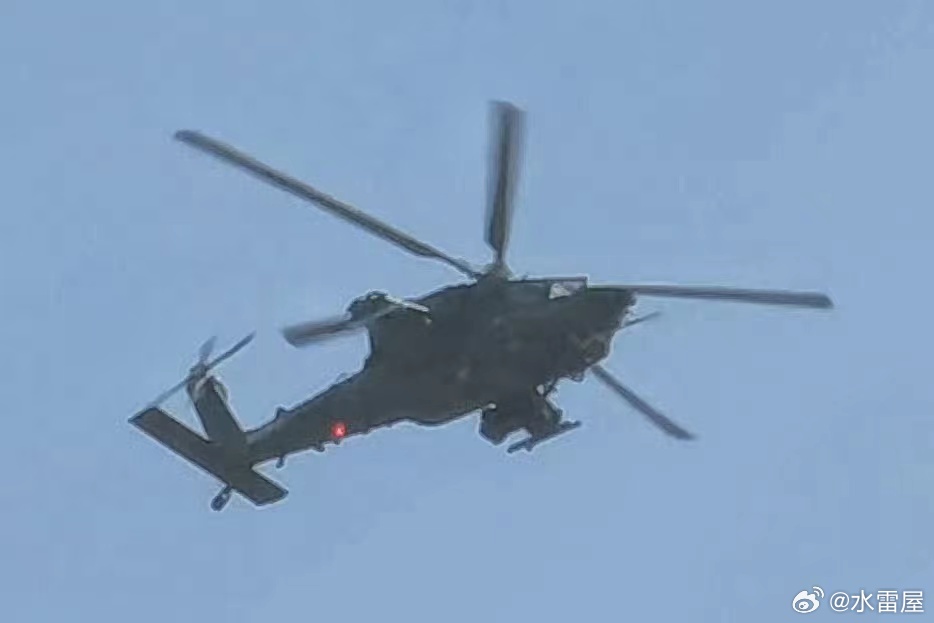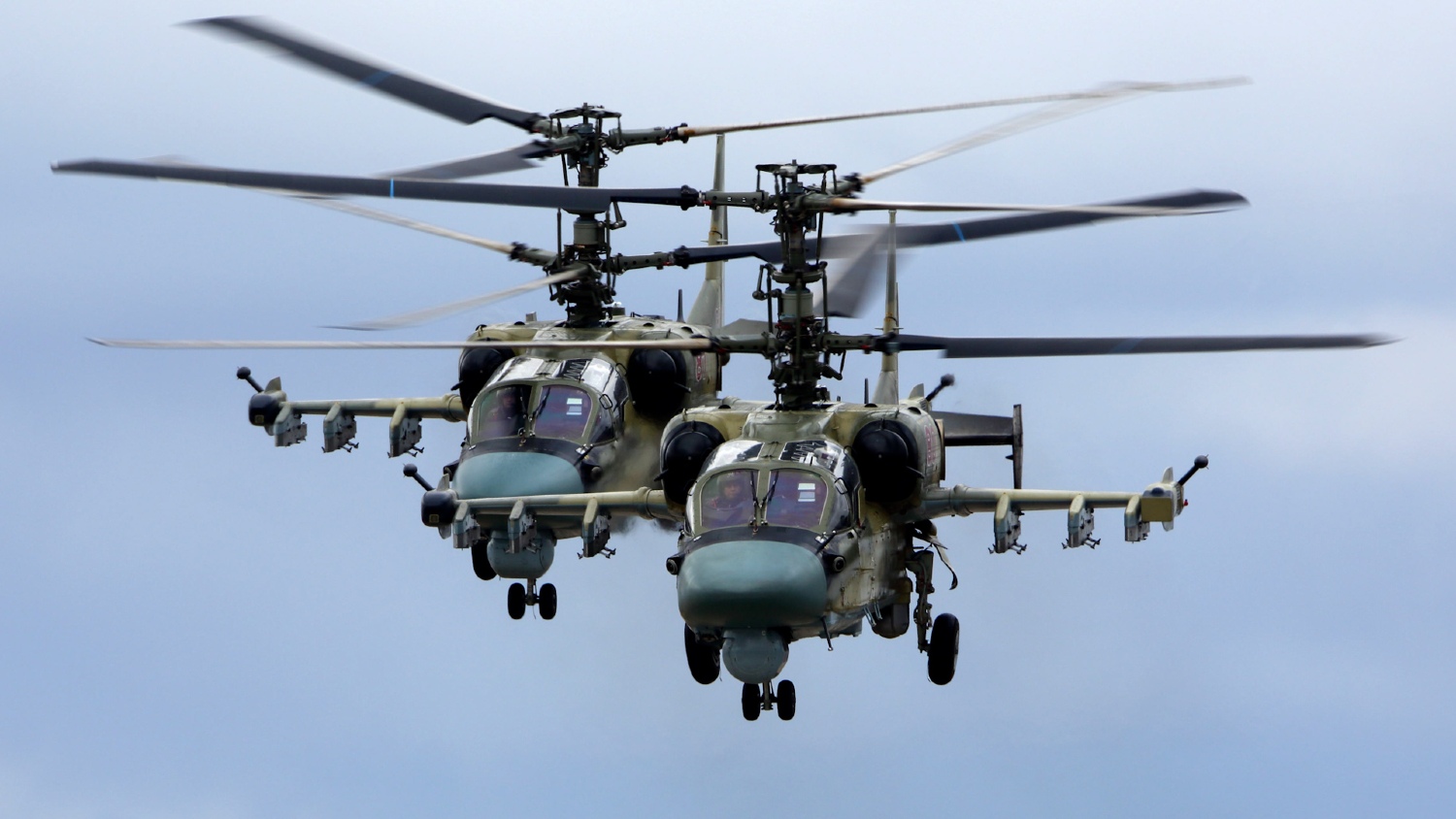A picture of China’s under-development heavy-class attack helicopter, the Z-21, has surfaced online. The new helicopter — captured in a bottom view while in flight and went around on the Chinese social media website Weibo — bore a striking resemblance to the Z-10, which is a medium-weight class chopper and is the mainstay of China’s heliborne support for ground operations.
The emergence of the picture also raises questions about the fate of the plan to purchase the Russian-made Ka-52K (Katran) attack helicopters. A naval version of Kamov’s Ka-52 attack helicopter, which is seeing massive use in Ukraine, was meant to operate from the PLA Navy’s Type 075 amphibious Landing Helicopter Dock (LHD) vessels.
Whether that plan progresses or is shelved remains to be seen. According to Western experts, China would nevertheless draw inspiration from Russia’s Ka-52 and other attack helicopter tactics in Ukraine.
The Ka-52, while being shot down in dozens, has also been responsible for devastating Ukraine’s armor and Western tanks, contributing to its failed counteroffensive in mid-2023.
Design Features
Chinese military aviation expert Andreas Rupprecht posted some of the pictures on X (formerly Twitter), saying the helicopter resembles the Z-10 or even the American AH-64 Apache in certain respects.

In the picture of the helicopter flying overhead, it appears to share the front fuselage and cockpit canopy design with the Harbin Z-10. The outboard wing stubs for holding weapons also have the same shape, with a slightly straight front and slanted/sloping rear. The angular features, however, do not seem very pronounced.
Like later batches of the Z-10, the helicopter’s engine exhausts are turned upwards. This is a measure against heat-seeking and infrared seeker anti-air missiles coming from the sides or upwards from the ground to miss the hot gasses.
The landing gears also look fixed and non-retractable. The chin is carrying what appears to be a pitot tube to measure airspeed and other aerodynamic characteristics, which implies that the aircraft is in the prototype testing stage.
Use In Taiwan Invasion
A Taiwan invasion would need a multiplicity of systems in a mutually supporting role, particularly while destroying ground targets as PLA Marine Brigade troops land on Taiwanese beaches and face heavy resistance from Taiwanese armor and artillery.
It would possibly have to fly at lower altitudes, closer to the ground, within range of Taiwanese air defense missiles and guns. This will need heavy armor to withstand punishment, a larger weapons payload to dish out pain while it takes it, and powerful electronic warfare (EW) systems to deflect incoming missiles.
The Z-10’s weight class would not allow such a load. Indeed, that does not diminish the Z-10’s utility; it would still serve as the leading rotary wing attack platform, undertaking both close air support and long-range standoff fires.
China Might Learn From Russian Ka-52 Alligator
A February 2024 article on the RAND Corporation noted that PLA rotary-wing aircraft might “deliver ‘air cavalry’ and special forces deep into the island’s interior…to disorient Taiwan’s defenders and prevent reinforcements from developing counterattacks against the PLA’s initial lodgments.”
But the Chinese would do this after studying the employment, tactics, and successes of the “Ka-52 Alligator…which (they) continue to be quite fixated on.” While 39 Ka-52s were lost in the “early part of the invasion,” according to the UK Ministry of Defence, the assessments were “significantly altered after its strong performance during Ukraine’s summer (2023) counteroffensive.”

Alligators destroyed a large number of Ukrainian armor and Western tanks like the German Leopard and American Bradley IFVs. Dozens of videos from the Ka-52’s electro-optical system released by the Russian Ministry of Defense (RuMoD) show the Ka-52 destroying tanks.
The distances were greater than 7 km, using the 9-A-4172K Vikhr-1 Anti-Tank Guided Missile (ATGM). (The Alligators’ role on the battlefield has been covered in previous EurAsian Times reports here, here, and here).
According to the RAND article, the Chinese saw that Russia developed “appropriate tactics,” where they stopped “exposing (the Ka-52s)” to Ukraine’s “dense air defense network.” They also showed “great effectiveness in night operations” and “improved their battlefield survivability through electronic warfare.”
This validates the analysis by EurAsian Times. “Instead of attempting to penetrate dense air defenses, the helicopters are instead called in ‘on demand’ to destroy targets of opportunity” before “rapidly exiting” in “hit and run tactics.”
The Ka-52 “fly very close to the ground” to “suddenly appear over a hill or out of a forest to make their missile attacks,” leaving little time for Ukrainian troops to target them. Other Russian tactics on the battlefield, including especially dense belts of land mines, assisted the Alligators. These repeatedly stalled Ukrainian armored thrusts and made their tanks and AFVs vulnerable targets for the Alligators.
Of the approximately 125 Ukrainian armored vehicles disabled in June 2023, more than 50 were disabled by Russian helicopter operations. A Ukrainian soldier also told the British press that the Alligator attacks were “dauntless and relentless, occurring three to four times per day.”
Taiwan Has Its Task Cut Out
While the Z-21’s development stage is not known, it can be assumed it is somewhere around the prototyping stage and has yet to enter limited series production (LSP). But its introduction buttresses a reality of the Taiwan situation: the military balance in the Straits is heavily skewed in China’s favor.
Taiwan might find a way to shoot down the Z-21 or a tactic to blunt its attack. But it would have to contend with the host of other weapons like strikes by fighter bombers like the Su-30MKK, J-11, J-16, J-10, strategic bombers like the H-6K, land strikes by a PLA Navy flotilla, UCAVs like the TB-001 Twin-Tailed Scorpion and amphibious ships landing troops and tanks on its shores.
All of them would act simultaneously, in a mutually complementing yet not dependent fashion, coalescing to support a larger strategic goal.
Put differently, attack helicopters would be only one tactical component of the range of systems China would deploy if it decides on a military recourse on Taiwan. Tackling anyone does not guarantee rolling back an encircling attack from all sides; rather, it requires a large, home-built military that can withstand a battle and heightened military production for several months, if not years.
- The author can be reached at satamp@gmail.com
- Follow EurAsian Times on Google News




